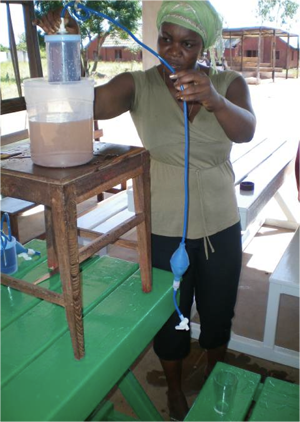Difference between revisions of "Solution of the week 6"
(→The Siphon filter) |
|||
| (One intermediate revision by the same user not shown) | |||
| Line 11: | Line 11: | ||
====The Siphon filter==== | ====The Siphon filter==== | ||
| − | So — 30$ | + | So — $30, $20, can we go lower? Enter the [[Siphon_filter|siphon filter]]. Produced by Basic Water Needs Foundation India, and sold under the brand name Tulip filter and CrystalPur, it is sold for $10. To reach that price point, the filter has been designed in such a way that only the most essential elements remain: a filter element, a tube, a tap. That’s it. |
| − | The ceramic filter element is made out of [http://en.wikipedia.org/wiki/Diatomaceous_earth diatomaceous earth], a wonderful substance consisting of the fossilized remains of diatoms, a type of hard-shelled | + | The ceramic filter element is made out of [http://en.wikipedia.org/wiki/Diatomaceous_earth diatomaceous earth], a wonderful substance consisting of the fossilized remains of diatoms, a type of hard-shelled algae. Their beautiful little skeletons contain extremely small holes, which are very suitable to act as a bacterial filter. The filters are impregnated with silver particles, which reduce regrowth of bacteria. Although bacteria are filtered effectively, candle-type ceramic filters have lower removal efficiency for viruses. To effectively remove these, ceramic filter filtration needs to be combined with a disinfectant such as chlorine. |
Latest revision as of 01:08, 19 May 2015
Extremely affordable water filters
A question: if we can fly to the moon, can we make a 1$ water filter for people to use in their homes? And, if the answer is yes, why haven’t we yet? This is one of my favourite things: the quest for extremely affordable point-of-use water filters.
There are some hopeful developments. After Hindustan Unilever had introduced their Pureit water purifier at a price level of 30$ for a very well-designed and effective water filter, protected by 21 patents and using 5 water filtration steps, Tata Company recently introduced their Tata Swach water purifier, at 20$, with 1 filtration step, but equaly good-looking. And we already had the Vestergaard LifeStraw Family 1.0 filter, also at $20. In the open source hardware corner, we have the biosand filters, and ceramic pot filters. Lots of good stuff.
These filters all use some combination of microfiltration, disinfection and adsorbtion. Microfiltration simply blocks bacteria from passing through the filter by using a highly porous material in which the bacteria basically get lost. Disinfection, for example using chlorine, kills bacteria and other pathogens using chemical means. Adsorbtion, finally, uses carbon to adsorb molucules, improving taste, smell, and colour of the water. Not all filters use all three, and this is where the main differences in quality lie.
The Siphon filter
So — $30, $20, can we go lower? Enter the siphon filter. Produced by Basic Water Needs Foundation India, and sold under the brand name Tulip filter and CrystalPur, it is sold for $10. To reach that price point, the filter has been designed in such a way that only the most essential elements remain: a filter element, a tube, a tap. That’s it.
The ceramic filter element is made out of diatomaceous earth, a wonderful substance consisting of the fossilized remains of diatoms, a type of hard-shelled algae. Their beautiful little skeletons contain extremely small holes, which are very suitable to act as a bacterial filter. The filters are impregnated with silver particles, which reduce regrowth of bacteria. Although bacteria are filtered effectively, candle-type ceramic filters have lower removal efficiency for viruses. To effectively remove these, ceramic filter filtration needs to be combined with a disinfectant such as chlorine.
Why it is smart
The brilliance of the filter lies in the tube. Because a ceramic filter is highly porous, it needs a certain amount of water pressure to push the water through. In the Siphon filter, the tube is used to siphon the water from a higher water container to a lower one, creating about 70cm of water pressure. This is enough to suck the water through the filter, creating a flow rate of about 5 liters per hour. Plenty.
The filter is cleaned by closing the tap and squeezing the rubber bulb, which pushes clean water back through the filter, which cleans it. Called ‘backwashing’, this significantly prolongs the lifetime of the filter. It’s small size makes it easy for small hardware and general stores to keep it in stock, and to distribute it on a large scale for emergency situations. The costs are kept low as storage pots for the water are not included: the filter can be used with storage pots that people already have.
At the moment, the filter is being implemented by EnterpriseWorks/VITA, and Connect International in Cambodia, Tanzania, Mozambique, Madagascar, Kenya, India, and other countries. Good luck people!


